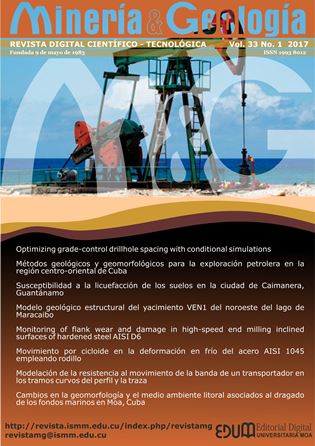Optimizing grade-control drillhole spacing with conditional simulations
Keywords:
drillhole spacing, conditional simulations, grade controlAbstract
This paper summarizes a method to determine the optimum spacing of grade-control drillholes drilled with reverse-circulation. The optimum drillhole spacing was defined as that one whose cost equals the cost of misclassifying ore and waste in selection mining units (SMU). The cost of misclassification of a given drillhole spacing is equal to the cost of processing waste misclassified as ore (Type I error) plus the value of the ore misclassified as waste (Type II error). Type I and Type II errors were deduced by comparing true and estimated grades at SMUs, in relation to a cuttoff grade value and assuming free ore selection. True grades at SMUs and grades at drillhole samples were generated with conditional simulations. A set of estimated grades at SMU, one per each drillhole spacing, were generated with ordinary kriging. This method was used to determine the optimum drillhole spacing in a gold deposit. The results showed that the cost of misclassification is sensitive to extreme block values and tend to be overrepresented. Capping SMU’s lost values and implementing diggability constraints was recommended to improve calculations of total misclassification costs.Downloads
References
BERTOLI, O.; PAUL, A.; CASLEY, Z. & DUNN, D. 2013: Geostatistical drillhole spacing analysis for coal resource classification in the Bowen Basin, Queensland. International Journal of Coal Geology 112: 107–113.
BOUCHER, A.; DIMITRAKOPOULOS, R. & VARGAS-GUZMÁN, J. A. 2005: Joint Simulations, Optimal Drillhole Spacing and the Role of the Stockpile. In: Geostatistics Banff 2004 [online]. Dordrecht: Springer Netherlands. p. 35–44. [Accessed 16 November 2016].
CHILÈS, J. P. & DELFINER, P. 2009: Geostatistics: Modeling Spatial Uncertainty [online]. Wiley. Wiley Series in Probability and Statistics.
GORIA, S.; GALLI, A. & ARMSTRONG, M. 2001: Quantifying the impact of additional drilling on an openpit gold project. In: 2001 annual conference of the International Association for Mathematical Geology. Cancun, Mexico.
JOURNEL, A. G. & KYRIAKIDIS, P. C. 2004: Evaluation of Mineral Reserves: A Simulation Approach. Oxford University Press. Applied Geostatistics.
LARRONDO, P. 2003: Entropy of Gaussian Random Functions and Consequences in Geostatistics [online]. Department of Civil & Environmental Engineering University of Alberta. CCG Annual Report. Available in: http://www.ccgalberta.com/ccgresources/report05/2003-129-entropy.pdf
MARTÍNEZ-VARGAS, A. 2016: PyGSLIB [online]. Python 2.7 package. Opengeostat Consulting. Available in: https://github.com/opengeostat/pygslib
VERLY, G.; POSTOLSKI, T. & PARKER, H. M. 2014: Assessing Uncertainty with Drill Hole Spacing Studies–Applications to Mineral Resources. In: Orebody Modelling and Strategic Mine Planning Symposium 2014. Australasian Institute of Mining and Metallurgy. Perth, Australia, 24-26 November.
Published
How to Cite
Issue
Section
Copyright (c) 2017 Adrian Martínez-Vargas

This work is licensed under a Creative Commons Attribution-NonCommercial 4.0 International License.
- Authors retain copyright and guaranteeing the right magazine to be the first publication of the work as licensed under a Creative Commons Attribution-NonCommercial that allows others to share the work with an acknowledgment of the work's authorship and initial publication in this journal.
- Authors may establish separate supplemental agreements for the exclusive distribution version of the work published in the journal (eg, place it in an institutional repository or publish it in a book), with an acknowledgment of its initial publication in this journal.
- Authors are allowed and recommended to disseminate their work through the Internet (e.g., in institutional telematic archives or on their websites) before and during the submission process, which can produce interesting exchanges and increase citations of the published work. (See The effect of open access)










